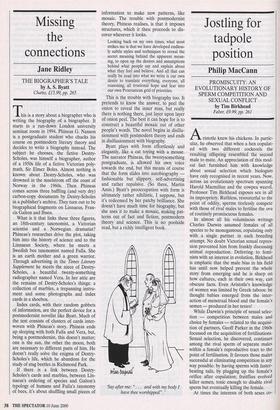Missing the connections
Jane Ridley
THE BIOGRAPHER'S TALE by A. S. Byatt
Chatto, £15.99, pp. 265 This is a story about a biographer who is writing the biography of a biographer. It starts in a run-down London university seminar room in 1994. Phineas G. Nanson is a postgraduate student who chucks his course on postmodern literary theory and decides to write a biography instead. The subject he chooses, the fictive Destry- Scholes, was himself a biographer, author of a 1950s life of a fictive Victorian poly- math, Sir Elmer Boles. Almost nothing is known about Destry-Scholes, who was drowned in the maelstrom off the coast of Norway in the 1960s. Then Phineas comes across three baffling (and very dry) carbon-copy documents by Destry-Scholes in a publisher's archive. They turn out to be biographical fragments on Linnaeus, Fran- cis Galton and Ibsen.
What is it that links these three figures, an 18th-century taxonomist, a Victorian scientist and a Norwegian dramatist? Phineas's researches drive the plot, taking him into the history of science and to the Linnaean Society, where he meets a Swedish bee taxonomist named Fulla. She is an earth mother and a green warrior. Through advertising in the Times Literal)? Supplement he meets the niece of Destry- Scholes, a beautiful twenty-something radiographer named Vera. In her attic are the remains of Destry-Scholes's things: a collection of marbles, a trepanning instru- ment and some photographs and index cards in a shoebox.
Index cards, with their random gobbets of information, are the perfect device for a postmodernist novelist like Byatt. Much of the text consists of clusters of cards inter- woven with Phineas's story. Phineas ends up sleeping with both Fulla and Vera, but, being a postmodernist, this doesn't matter; one is the sun, the other the moon, both are necessary to different parts of him. He doesn't really solve the enigma of Destry- Scholes's life, which he abandons for the study of stag beetles in Richmond Park.
If there is a link between Destry- Scholes's cards and marbles, between Lin- naeus's ordering of species and Galton's typology of humans and Fulla's taxonomy of bees, it's about shuffling small pieces of information to make new patterns, like mosaic. The trouble with postmodernist theory, Phineas realises, is that it imposes structures, which it then proceeds to dis- cover wherever it looks.
Looking back on my own times, what most strikes me is that we have developed endless- ly subtle styles and techniques to reveal the secret meaning behind the apparent mean- ing, to open up the desires and assumptions behind what people say and explain about what they feel and believe. And all that can really be read into what we write is our own desire to translate everything, everyone, all reasoning, all irrational hope and fear into our own Procrustean grid of priorities.
This is the trouble with biography too. It pretends to know the answer, to peel the onion to reveal the inner man, but really there is nothing there, just layer upon layer of onion peel. The best it can hope for is to construct a beautiful mosaic out of other people's words. The novel begins in disillu- sionment with postmodern theory and ends in disillusionment with biography.
Byatt plays with form effortlessly and elegantly, like a cat toying with a mouse. The narrator Phineas, the twentysomething postgraduate, is allowed his own voice towards the end, but this means of course that the form slides into autobiography fashionable but slippery, self-advertising and rather repulsive. (So there, Martin Amis.) Byatt's preoccupation with form is ultimately rather nihilistic, I suppose, but it's redeemed by her patchy brilliance. She doesn't have much time for biography, but she uses it to make a mosaic, making pat- terns out of fact and fiction, postmodern theory and science. This is no poolside read, but a richly intelligent book.
`Say after me: " . . . and with my body I have thee worshipped" .'
































































 Previous page
Previous page